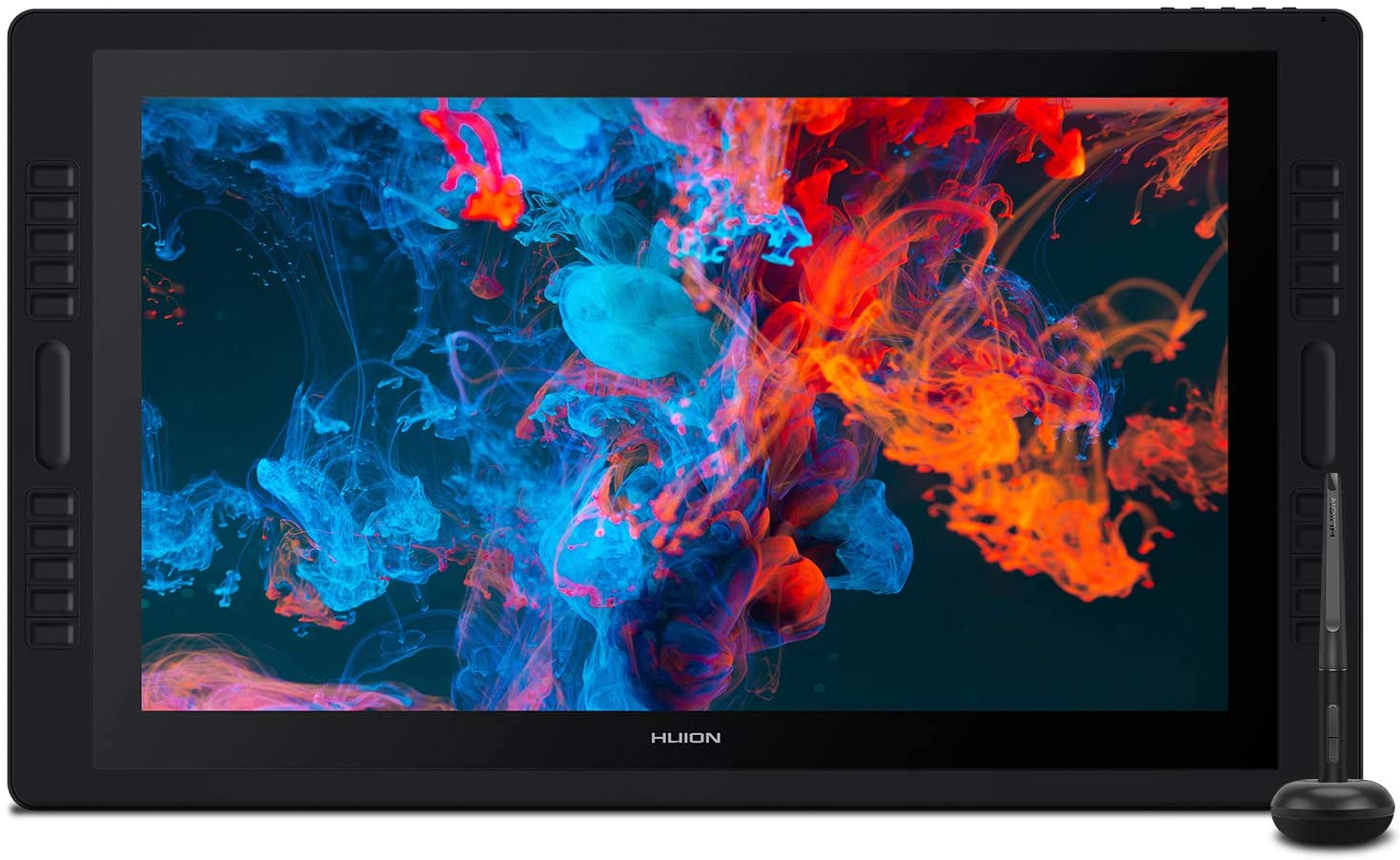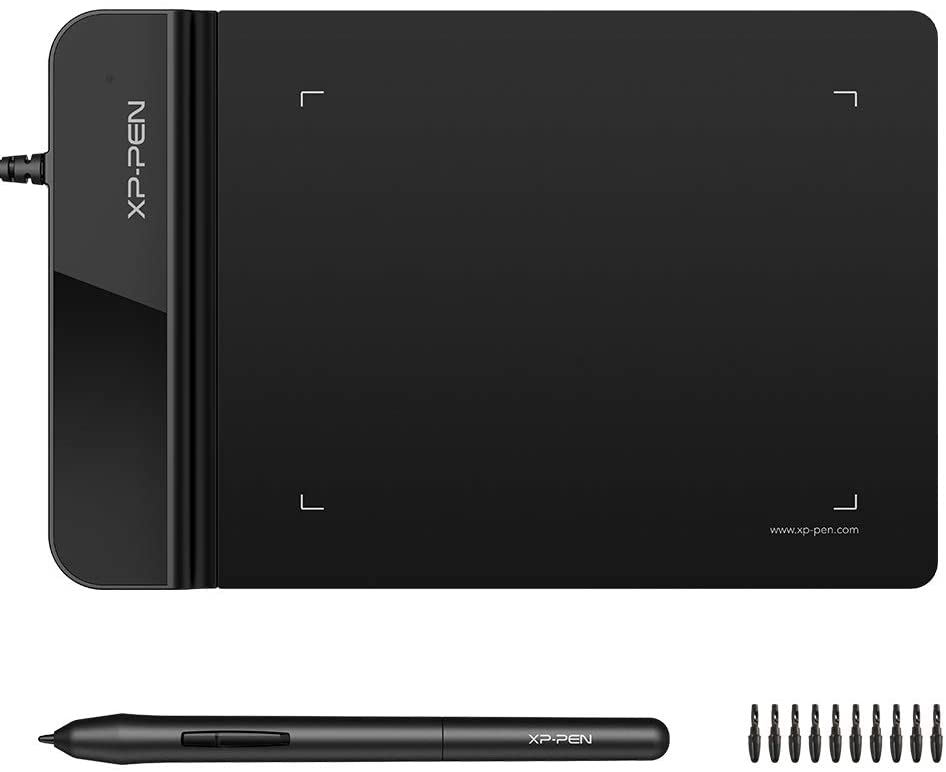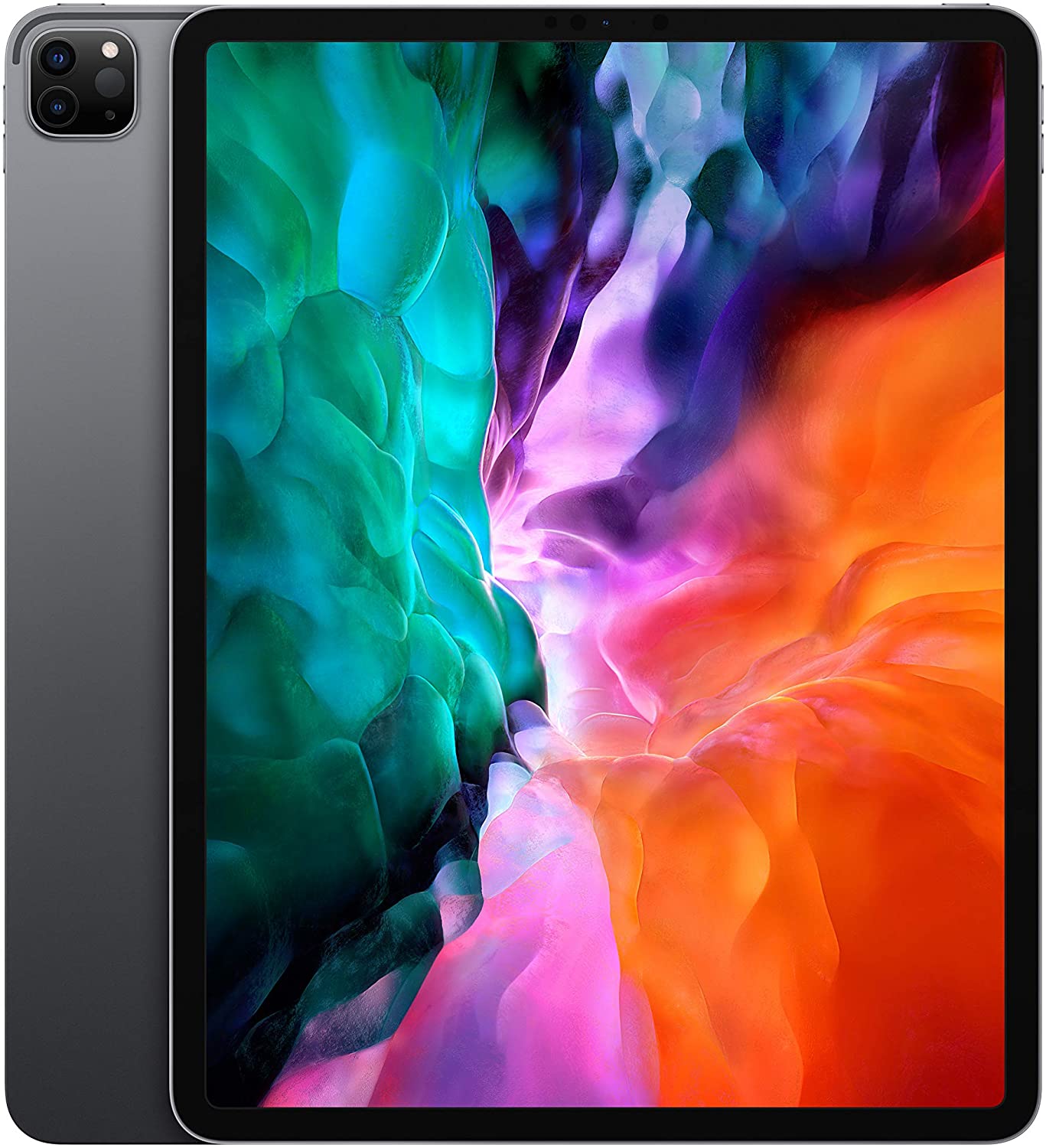The Best Drawing Tablets for Your Money
A drawing tablet is a dedicated tool that allows digital artists to create everything from quick sketches to polished masterpieces online — with much more flexibility and speed compared to traditional pens, pencils and brushes.
A staple tool for many digital artists is a drawing tablet.
Drawing tablets typically consist of a rough surface or a highly sensitive LCD monitor upon which you can draw using a pen-like stylus that’s responsive to different pressure levels.
There are three types of drawing tablets: graphics tablets, pen displays and tablet computers. Read on to learn more about how they work, then check out our picks for the best drawing tablets.
Drawing tablets: Graphics tablet vs. pen display vs. iPad
Graphics tablets, also known as pen pads, are the most affordable of the three. These traditional drawing tablets resemble a trackpad or mousepad. In fact, they’re high-tech pads with no display or monitor that connect to the computer through a USB cable. They offer a pressure sensitive surface that processes the stylus movements and lets you see them on your computer screen, where your creations can be saved
Pen displays, on the other hand, are drawing tablets with highly sensitive built-in touchscreen monitors that you can use to draw with a stylus. Because they have their own monitors, you watch your creations as you draw them, without the sense of disconnect you get from graphics tablets.
Lastly, there are tablet computers. They’re the tablets most people are familiar with. These powerful multitaskers not only work as traditional tablets used for streaming and everyday tasks, but offer enough pressure sensitivity and capabilities to perform as drawing tablets. This category includes tablets such as the iPad, Samsung Galaxy Tab and the Microsoft Surface Book. Some of these tablet computers may already include their own pen stylus, but others like the iPad require you to buy it separately.
Pricing can vary widely based on the type of drawing tablet you purchase. For instance, graphics tablets, which are the cheapest of the three, can range anywhere from $30 upward to $600. Some affordable pen displays can retail from $150 to $600, whereas premium pen displays and top-quality tablet computers can easily cost $1,000 to over $3,000.
Drawing tablets buying guide
Once you’ve decided what type of drawing tablet works best for you, consider the following factors:
• Pressure sensitivity. Pressure sensitivity is one of the most important features of a drawing tablet. It allows you to control the weight of the pen. In other words, you can adjust the thickness of a line based on how hard you press down the stylus onto the tablet.
Pressure sensitivity is measured in levels, ranging from 300 up to 8,192. The higher the level, the more movements the tablet can detect and differentiate. Most of our selected contenders feature the maximum pressure sensitivity of 8,192 levels.
• Active area. The active area of a drawing tablet refers to the available space to draw. It corresponds to the size of the tablet, meaning that small tablets will have smaller active areas.
A larger active area gives you more space to draw and the flexibility to work on larger projects without movement constraints. Tablets with smaller active areas, on the other hand, are good for students and enthusiasts who are starting to develop their skills. They’re convenient for small offices or if you want something more portable too.
• Shortcut keys. Shortcut keys or express keys are programmable buttons that you can customize with frequently used tools or commands of your preference. They can make your drawing process more efficient and help speed up your workflow by giving quick access to specific functions.
Not all tablets have shortcut keys, especially not cheap graphics tablets. But most do, and typically include at least eight express keys. Some premium models can have 20 or more programmable buttons.
• Size. Drawing tablets come in many different sizes. Small models can be just a few inches wide, similar in size to a mousepad. Medium size tablets, on the other hand, can be as wide as a wireless keyboard, while larger models can take up half your desk.
If you’re looking for portability, graphics tablets are typically smaller and a good option. You might also consider pen displays that measure between 10” and 12”. Just remember that the smaller the tablet, the less active area you’ll have available to draw.
• Resolution. If you’re shopping for a pen display, you want to make sure you’ll be able to value all the details and colors of your artwork on its built-in screen. There are pen displays with high-definition and 4K resolution, and the latter tend to be more expensive.
Do note that tablets with higher resolution are typically bigger, so you may also need some extra desk space for them.
• Software compatibility. Because most drawing tablets need to be connected to a computer to work, it’s important that you verify whether the tablet is compatible with the operating system you are using. Most drawing tablets are compatible with Windows and Mac, and some may be used with Linux.
Best drawing tablets
1. Best overall: Wacom Cintiq Pro 24 (DTK2420K0)
Active area: 20.55” x 11.57” | Resolution: 3840 x 2160 4K | Pressure sensitivity: 8,192 levels | Shortcut keys: 17 | OS support: Windows 7 or later, MacOS 10.11 or later | Size: 24”
The Cintiq Pro 24 is Wacom’s medium-size model of its professional pen display line and one of the best tools for illustrators and designers.
This 24” drawing tablet features an impressive 4K display with anti-glare screen glass that’s perfect to appreciate colors and every single detail of your artwork. The large active area (20.55” x 11.57”) lets you move your hand freely and work without worrying about space constraints.
It comes with a remote with 17 programmable buttons that can be configured with shortcuts of your preference. This way you can speed up your workflow by accessing tools and executing specific commands, such as copy, paste and edit, with just one click. The included Pen Pro 2 stylus also has two buttons to switch from brushes to the eraser whenever you need it, and a pressure sensitivity of 8,192 levels.
The Cintiq Pro 24 doesn't come cheap, however. It costs a hefty $2,000, which may be a drawback if you’re on a budget. Additionally, it’s bulky, heavy (about 16 pounds) and not so portable. It also means that you need plenty of desk space.
That being said, it has a pair of pop-out legs that let you raise the tablet to a 20° angle. It can also be used with any compatible stand, such as the Wacom Ergo Stand, which provides more flexibility and lets you raise, tilt and rotate the tablet freely to any position you want.
If you can do without the 4K display, consider the Wacom Cintiq 22. It is 2” smaller than the Cintiq Pro 24, with a high-definition display, and costs about $800 less. This non-pro model is also available with a 15.6” display at a more affordable price, typically around $650. Do note that these two smaller, cheaper models don’t have customizable shortcut buttons. Nonetheless you can purchase the Wacom Express Key Remote for about $90 and would still be paying less money than if you buy the Cintiq Pro 24.
2. Editor’s pick: Huion Kamvas Pro 24
Active area: 20.74” x 11.67” | Resolution: 2560 x 1440 QHD | Pressure sensitivity: 8,192 levels | Shortcut keys: 20 | OS support: Windows 7 or later, MacOS 10.12 or later | Size: 24”
The Kamvas Pro 24 is Huion’s largest pen display and a more affordable alternative to the Wacom Cintiq Pro 24.
It combines QHD resolution (2560 pixels by 1440 pixels) with a matte glass laminated display that overall contributes to a better screen clarity and sharper colors than regular high-definition pen displays. It has a considerably large active area of 20.74” x 11.67” and a symmetrical design that’s perfect for both right and left-handed users.
The Kamvas Pro 24 comes with a battery-free stylus that supports 8,192 levels of pressure sensitivity and a 60° tilt function. Like many other pen styluses, Huion’s digital pen features two programmable buttons on the side, which you can configure with any function of your liking.
It also offers a total of 20 express keys, 10 on each side, meaning that you have plenty of buttons to set shortcuts for frequently used functions and tools. Additionally, it comes with a stand that allows you to adjust the angle of the tablet anywhere from 20° to 80°. However, when the Kamvas Pro 24 is in a flat position, the stand causes it to be a little wobbly, which may be an annoyance, according to some reviewers.
The Huion Kamvas Pro 24 costs $900, which is roughly $1,000 less than our best overall pick, the Wacom Cintiq Pro 24.
3. Best for low prices: XP-Pen G430S Graphic Tablet
Active area: 4” x 3” | Pressure sensitivity: 8,192 levels | OS support: Windows 7 or later, MacOS 10.14 or later
The XP-Pen G430S is an ultra-thin and compact pen pad tablet that’s ideal for graphic arts enthusiasts and novices who want to start practicing without breaking the bank.
This affordable graphics tablet costs around $30, and features a 4” x 3” active area that, while small, can be used to sketch, draw or even do some digital painting. It is also a good choice for businesses and professionals who need a pad for signing electronic documents. Additionally, the tablet is designed for both right and left-handed users.
The XP-Pen G430S comes with a battery-free pen stylus, which doesn’t require charging and acts as if it were a real pen. It can reach up to 8,192 levels of pressure sensitivity and allows you to create and modify brush pallets. It also has two buttons near the grip that let you toggle to the eraser.
The tablet is compatible with Windows, Mac and Linux. It can be used with most graphic applications including, but not limited to, Photoshop, Adobe Illustrator, Painter and ZBrush. It can also be synced with Adobe Acrobat Reader, Microsoft Word, Powerpoint and other signature applications.
If you prefer a drawing board with a larger active area, consider the XP-Pen Deco 01 V2. It features a 10” x 6.5” active area, a pen and eight customizable shortcut keys for about $40 more than the XP-Pen G430S.
4. Best for low prices runner-up: Gaomon PD1161 Drawing Tablet
Active area: 10” x 5.7” | Resolution: 1920 x 1080 HD | Pressure sensitivity: 8,192 levels | Shortcut keys: 8 | OS support: Windows 7 or later, MacOS 10.12 or later | Size: 11.6”
The Gaomon PD1161 is a budget-friendly option for those who prefer a pen display (a drawing tablet with a built-in screen) over a pen pad like the XP-Pen G430S.
For about $200, the Gaomon offers an active drawing area of 10” x 5.7” and a high-definition screen for vivid display. It features eight programmable shortcut keys, which can be set to work as zoom in/out, save, undo, erase and other similar functions. The tablet is compatible with Windows and Mac operating systems, and with most drawing programs, such as Photoshop, PaintTool SAI, Sketchbook and Adobe Illustrator.
Like most drawing tablets, the Gaomon PD1161 ships with a pen stylus. The pen features 8,192 levels of pressure sensitivity and doesn’t require batteries or charging. On the grip it has two programmable buttons that as default allow you to switch between the eraser and right click. It comes with a pen holder and eight pen nibs, so you don’t have to worry about buying replacements for a while.
The Gaomon PD1161 doesn’t have a stand on the back. This may be a drawback if you want a drawing tablet that adjusts to different angles and positions to fit your posture. Nonetheless, you can buy Gaomon’s adjustable stand for an additional $50.
If a 11.6” tablet sounds a bit cramped for your tastes, consider the Gaomon PD1560. It is slightly bigger (15.6”) and features two more shortcut keys and a stand. All for about $100 more than the Gaomon PD1161.
5. Best drawing pad: Wacom Intuos Pro Large (PTH860)
Active area: 12.1” x 8.4” | Pressure sensitivity: 8,192 levels | Shortcut keys: 8 | OS support: Windows 7 or later, Mac OS 10.12 or later | Size: 16.8” x 11.2”
If you’re looking for a graphics tablet with a large area to sketch, illustrate and design your work freely, consider the Wacom Intuos Pro Large.
This ultra-slim drawing pad is ideal for working with art that requires large movements and space. It has an active area of 12.1” x 8.4” and a multi-touch surface that’s responsive to finger movements, meaning that you can adjust and zoom your drawings as you’d do with a touch screen.
It features one of Wacom’s advanced styluses, the Pro Pen 2. The stylus delivers accurate performance, outstanding tilt recognition and 8,192 levels of pressure sensitivity which contribute to an overall paper-like feel. The tablet can also be used with Wacom’s alternative pens, such as the Pro Pen 3D, in case you work with 3D and 2D applications.
Another great thing about the Wacom Intuos Pro is that it has built-in Bluetooth, so it can connect with your PC or Mac wirelessly or using the included USB cable. However, some customers complain the Intuos Pro has a short battery life when unplugged and connected through Bluetooth.
The Wacom Intuos Pro comes with a two-month free trial of Adobe After Effects and Adobe Premiere Pro and a three-month license to use Boris FX, a software suite that includes tools for video and image editing, visual effects and post-production.
The Wacom Intuos Pro is available in two other sizes, small and medium. The small Intuos Pro model has an active area of 6.3” x 3.9”, whereas the medium model has an active drawing area of 8.7” x 5.8”. They cost around $250 and $380, respectively.
6. Best for Mac users: Apple iPad Pro 12.9 (2020)
Active area: 10.32” x 7.74” | Resolution: 2732 x 2408 | Pressure sensitivity: Not specified | OS support: iPadOS | Size: 12.9”
The iPad Pro is a powerful multitasker for digital creators looking for a self-sufficient workstation that offers so many more functions than a traditional drawing pad or pen display.
For starters, the iPad Pro is a fully-operational tablet, meaning that unlike most drawing tablets it runs all types of apps and doesn’t need to be connected to a Mac or a PC to work. In other words, it can be used to watch Netflix, browse online and perform all types of everyday tasks anywhere.
The iPad Pro has a great drawing surface with palm rejection so you can rest your palm on the screen as if it were a paper sheet without affecting the touch screen response. Its companion, the Apple Pencil 2, offers accuracy and good pressure sensitivity for you to have control over the pressure of your strokes and fine lines. It supports tilt movements as well, so you can draw from angles. Plus, double tapping the pen lets you switch from the pen to the eraser. A drawback, however, is that unfortunately the Apple Pencil costs extra, adding $120 to your total.
The iPad Pro has access to a wide range of drawing, design and illustration apps, such as Procreate, Photoshop, Adobe Fresco and Lightroom. This makes it a well-rounded tablet to sketch and design everywhere you go.
Additionally, if you own a MacBook, you can download the Astropad app, which allows you to use the iPad Pro as a wireless drawing pad. This means that you can draw directly into Photoshop and other creative software for Mac (such as Illustrator, Manga Studio and Affinity), using your iPad Pro as you would a Wacom pen display. Do note, the Astropad app costs an additional $30 at the time of this writing.
The iPad Pro features the A12Z Bionic chip processor with an 8-core graphics engine, and it’s available with multiple storage configurations ranging from 128GB to 1TB, with prices ranging from $900 to $1,400.
Another good contender is the iPad Air 4th Gen, which offers similar power at a more affordable price (around $600 with the base configuration). It’s slightly smaller than the iPad Pro, with a size of 10.9”, yet it’s compatible with the Apple Pencil 2 and also has access to a wide range of drawing apps, which makes it a great choice for enthusiasts and art students.
More from Money:
The Best Mesh Wi-Fi Systems for Your Money






